Explore Shekhawati: “the world’s largest open-air art gallery” in Rajasthan
There are four major regions of Rajasthan like, Shekhawati, Mewar, Marwar and Hadoti. Shekhawati is known for some famous mansions or havelies which are painted with traditional art forms. Even this city is the origin of some prestigious families like Birla, Poddar, Bajaj, Jhunjhunwala, Khaitan, Oswal, Piramal, Ruia, Singhania, and Goenka.
People may think that Shekhawati is a crowded place where thousands of tourists visit every month. But in reality, Shekhawati is a less explored area in Rajasthan where you can travel through some historical periods.
History of Shekhawati: a historical place of Rajasthan

The word ‘Shekhawati‘ originated from the ‘Garden of the Shekhas’. It comes from Rao Shekha who was the chief of a tribal community called Barwada. They used to rule in Amer which is currently known as Jaipur.
Rao always maintains a status of a quo and he was the first chieftain who signed a treaty with Amer that made him an independent ruler. Afterwards, the legacy of Shekhawati got linked with the Mughals, British East India Company and the state come under the British rule.
You can find a few strong pieces of evidence of Shekhawati in Marukantar Desha period of Ramayana. As we know that over the 16 mahajanapadas period to Buddha, we can find only two Janapadas like Avanti and Virata in Rajasthan.

Shekhawati was influenced by Avanti and later, it was occupied by Nandas of Magadha. According to some historians, Rajasthan, as well as Shekhawati, was obtained by Mauyas from Nandas. On the other part, during the ancient period, Shekhawati was divided into several janapadas and it was known as Matsya Kingdom.
Every Janapada was a free republic state and this system was developed by Aryan. After Gupta Dynasty, some parts of Shekhawati like, Jhunjhunu, Fatehpur, and Narhar were occupied by the Kaimkhanis, and later the entire Shekhawati region was occupied by Rajputs.
Rajasthan is a place of Rajputs and still, you can find some Rajput families in Rajasthan. It is true that they have lost their kingdom after India’s independence, but they have strong influences in Rajasthan. Shekhawati was founded and ruled by Shekhawat Rajputs, and Rao Shekha from Dhundhar established his independent kingdom with the capital at Amarsar.
After Rao Shekha, Rajasthan, as well as Shekhawati, was ruled by several rulers from the same dynasty as Rao Raimal, Rao Suja, and Rao Lunkaran. In the time of Rao Shekha, Shekhawati was divided into 33 thikanas which was known as Pargana. Each of them had their fort which was structured by mud and later, Rajputs developed some stone embedded forms in these Parganas as their head office. Even a few of them had their flag and emblems.
Explore a new horizon of fresco traditional painting in Shekhawati:

We always count the different regions of Rajasthan for their rich heritage and we can find some unnamed forts in Rajasthan. In Shekhawati, most of the buildings were constructed between the 18th to 20th centuries. The havelis are known for their frescos paintings which are based on historical and mythological themes.
Such frescos paintings hold major historical importance, and ancient gods, goddesses, animals, lifestyles, the life of Lord Ram and Krishna are magnificently described through these fresco paintings.
Along with the fresco wall paintings, you can find some murals in Shekhawati and these are influenced or developed by the Mughal kings. But murals in Shekhawati mainly described the religious indictments of the Mughal period by using animals and men as symbols or motif.
After the Mughal period, fresco wall painting was started and most of the artists described their imaginary outcomes through some traditional Indian figures, especially with the images of Lord Krishna and Rama. Apart from that, you will find some glimpses of the early lifestyle of Rajputs, layout of the town, and images of the local legends in these fresco paintings.
Almost all the town in Shekhawati has some fresco paintings, but you can find ancient or traditional ones on Mandawa, Ramgarh, Fatehpur, Nawalgarh, Bissau, Dundlod, and Alsisar.
The artists of fresco paintings were known as chiteras and they belong to potter or the Kumhar caste. Chiteras means manson, and they worked as builders and painters.
You will get surprised that such artists were used to painting the wall and building with natural colors because no artificial colors were developed during that time. They used to have some natural materials for their art like red stone powder, saffron, yellow clay, lamp black, lime, and plaster.
Architectural Style of Havelis in Shekhawati:

The word ‘fresco’ can be found in Michelangelo’s ‘The Creation of Adam’ and it is described the art of painting done by natural and wet plasters. If you want to explore some fresco arts then you must visit Shekhawati once because here you can find numerous havelis that designed with fresco paintings. Especially, you can find such havelis in Fatehpur, Nawalgarh, Jhunjhunu and Mandawa regions of Shekhawati.
Earlier, traders or Bania in Rajasthan used to earn huge loyalty from their business, but they did not invest such amounts for building their own havelis. Rajput kings were wealthy enough to establish some magnificent havelis in Shekhawati and they were structured some havelis with particular theme and motifs.

But, you can find some small mansions made by traders in Shekhawati and these havelis are painted with fresco painting. Ilay Cooper already mentioned such paintings in his books named “The Painted Towns of Shekhawati” and he has written that those unexplored havelis were built by the Bania or traders.
They used to build such small havelis to represent their social status. You can travel through some small villages in Shekhawati to explore such havelis built between 1830 -1930. But, you will get surprised to see the significant proofs of the time machine in these havelis.
Do you know that an aeroplane was painted on the Belgian glass during that time? Even, Lord Krishna and his gopikas were painted with some modern ornaments designed with lapis lazuli and gold. We know that such fresco images were developed by the imagination of the painters, but they have predicted the future through their artworks, which is quite surprising.
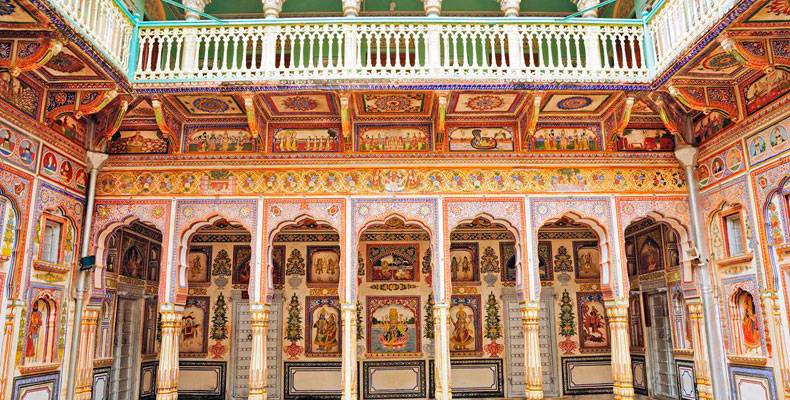
Structure of the havelis in Shekhawati share some common layouts and you can find deep influences of Mughal’s artworks in their structures. Most of the havelis have at least two floors and the upper floors of these havelis are designed as an open balcony, which was known as ‘chajja’.
Apart from that, you can find few rooms on the terrace of these havelis and the ground floor of these mansions are designed separately to make a uniform structure.
Apart from that, you can find some elevated ramps on these havelis and their main entrance is designed with huge doors made with metal and carved wood. You can find some images of Lord Krishna, Lord Ganesha and other Hindu gods on the above lintel of these havelis.
Earlier, people used to engrave such images of the Hindu god and goddess on their main entrance to protect their family and property from the evil eye. Each havelis has a common room at the ground floor for Baithak where male guests were done their official meetings.

These public reception areas are designed with some arched seating system and you can find a wall blocking window at the end of this common room. People used to identify their guests from the interior through this window.
Even you can find some rooms for women at the high above level of these common rooms in few havelis. Women did not allow to participate in these common Baithaks and they used to see the recreational activities and cultural shows from their hidden rooms.
But relatives can enter into the main haveli and you can find three side courtyards in these havelis. People can move from one courtyard to another through the walkway known as firnee. Even such courtyards were made for men and women separately, and Mardana of men’s courtyard was designed as the semi-private courtyard. On the other part, courtyards for women called Zenana were mostly designed inside the havelis. All these courtyards have private kitchen and storerooms.

Apart from that, the ground floor courtyard was used by the elder people and the young generation can use the upper floor one. Even you can find separate garages and driveways beside these havelis in Shekhawati which are known as Nohra.
According to the recent reports, the Rajasthan government has banned to sell these havelis and they are going to take such havelis under the Heritage Development Council for Prevention and Restoration Department.
Today, most of the havelis in Shekhawati are empty and their owners were shifted to major cities like Kolkata, Mumbai, and Delhi for business purposes. Even present owners are using some cheap materials like concrete to repair their Havelis and sell them off.
They do not take any step to restore their ancient arts and they do not want to preserve the legacy of their ancestors.
The different towns of Explore Shekhawati:
As stated earlier that Shekhawati has different towns and you can find some glimpses of ancient history in each town of Shekhawati. But major attractions are present in popular towns like Mandawa, Nawalgarh, Alsisar, Dundlod, and Fetahpur in Shekhawati.
Here you can find some details of these towns:
Mandawa:

It is a small town situated in northern Rajasthan and Mandawa is known as the fort town of Shekhawati. This place is a well known shooting spot and you can find the background of Mandawa in major Hindi movies.
But, numerous havelis of Mandawa can attract you most and you can find some famous mansions in Mandawa that will remind the cultural and social heritage of our country. There are various forts and havelis in Mandawa and you can find some famous tourist spots here:
Mandawa fort:

This is the only fort in Rajasthan where you can find some fresco paintings that describes the early childhood to youth age of Lord Krishna. Intricate carvings on the walls, splendid architectural designs, mirror works and fresco paintings on the walls and roof of this fort will never disappoint you. Earlier, the Durbar Hall of Mandawa Fort converted into the exhibition hall where major paintings and antiques were showcased. But, now the fort becomes a hotel and you can stay here to explore the panoramic view of the entire town.
Lakshminarayan Ladia Haveli:

Manawa is also known as the fairytale town of Rajasthan because you can go through the Rajput era through the Lakshminarayan Ladia Haveli. This haveli is designed with marvel you can find some blue washed paintings, murals, and sculptures here. The theme of the architecture of this haveli is based on the Hindu mythological theme and you can capture amidst the beauty of Aravallies from this haveli.
Mohan Lal Saraf Haveli:

If you want to explore some portraits and paintings then you must visit this place once because this haveli is decorated with lots of fresco paintings. Special halls along with the latticed windows of this haveli can attract you more and you can find some significant symbols of the medieval era in this haveli.
Apart from these sports in Manawa, you can also visit other tourist sports like, Thakurji Temple, Harlalka Well, Goenka chattri, Tanu Manu Saraf Haveli and Akhramka Haveli. Book Golden Triangle Tour With Mandawa to dig into this spiritual city of Rajasthan.
Alsisar:

It is a small town of the North-Western Rajasthan. Alsisar is famous for its havelis, mansions, castle, and cenotaphs. But, this is a town of Rajasthan where you can find extreme temperatures during summer and it can rise up to 48 degrees Celsius. On the other part, during winter, the temperature of Alsisar can drop below zero levels.
Here, you can find various havelis like, Alsisar Fort, Kataruka Ki Haveli, Shri Lal Bahadur Mal ki Haveli, Ramjas Jhunjhunuwala ki havelis, Lakha ka ki havelis, Arjun Ram khetan havelis and Cenotaph of Thakur Chhotu Singh and lots more. But apart from Alsisar fort, all the havelis are made by traders or Bania’s family.
Alsisar Fort:

Alsisar Mahal was built by the Shekhawar Thikanedars and Thakur Gaj Singh Ji is the present owner of this mahal. The restoration of this fort is done by Thakur family and you can stay inside this fort for few nights. Today, it is known as Alsisar Mahal or Alsisar hotel in Rajasthan. Rajput architecture designed with fresh paintings is the most attractive part of this fort and you can experience Rajput hospitality in this hotel.
Temple town:
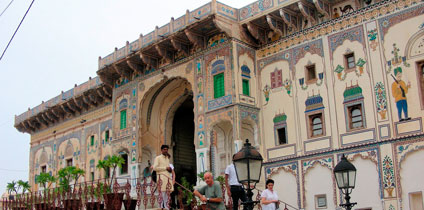
Alsisar is also known as temple town of Shekhawati and from this fort you can explore different temples like, Kejriwal Haveli, Laxmi Narayan temple, Cenotaph of Thakur Chhatu Singh Ji, Shri Lal Bahadur Mal Ki Haveli, Tejpal Jhunjhunuwala Ki Haveli, Ramjas Jhunjhunuwala Ki Haveli , Lakhaka Ki Haveli, Mahali Dutt Khaitan Haveli, Shri and Shyam Temple.
Festival:

If you have a plan to visit Rajasthan during December then you must join the Magnetic Fields Festival organized by Alsisar Mahal. This is a three-day festival of contemporary music and arts, and here you can find the blend of folklore with contemporary music.
Dundlod:

Dundlod is a part of Jhunjhunu district and it is satiated in Shekhawati of Rajasthan. As stated that each and every haveli of Shekhawati has its own story and if you want to explore the rich culture, colors and cuisines of Rajasthan then you must visit Dundlod once in your life.
The guide will narrate stories of princes and brave soldiers, and you will see the virtual history of Rajasthan through their words. The best places to see in Dundlod are:
Badalgarh Fort:
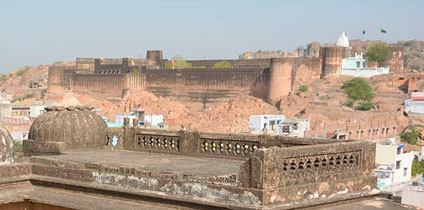
This fort covered with 900sq km is situated on the Nehra hilltop. Badalgarh Fort was built up by Nawab Faizal Khan, and you can find a unique structure inside the fort that was constructed to keep all the invaders out. Today, the fort becomes a hotel and you can stay in luxury inside this fort.
Fort of Dundlod:

Most of the forts in Rajasthan were designed with Mughal and Rajput architecture. The best example of such designs is Fort of Dundlod because here you can find the Diwan Khana which is designed with the Mughal style and furnished by French antique furniture.
Still, a major part of this fort used by the royal family and rest parts are open for guests. Now it is a heritage hotel where you can explore some artifacts like French traditional and antique furniture, paintings, weapons, and armors.
Tuganram Goenka Haveli:
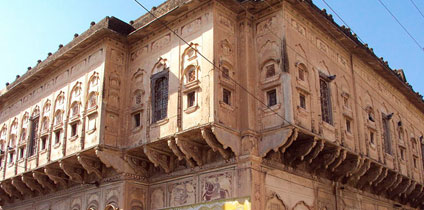
Tuganram Goenka was a wealthy merchant who built this haveli with some paintings and stationary pieces of art. Here you can find some paintings that described the famous love story of Dhola-Maru, and few paintings will narrate the story of wars between Rajputs and Mughals.
The courtyard settings with several floors and separate rooms for men and women of this haveli will attract you most. But, it is very disappointing that you can find the faded paintings on the walls of this haveli which needs restoration and proper preservation.
Other places:
Apart from these above havelis, you can also visit Satyanarayan Temple which is located in Goenka Haveli, and you must visit Jagathia Haveli in Dundlod. In this haveli, you can find a large open art gallery where you can find some fresco paintings, artifacts and lots more.
Nawalgarh:

Nawalgarh is located 30km away from Jhunjhumu district of Shekhawati. According to the common people of Nawalgarh, Marwaries who were relocated from Nawalgarh to some cosmopolitan cities like, Kolkata and Mumbai, they used to send their earned money to their states situated in Nawalgarh. Still, some of the families of Nawalgarh maintaining their havelis and you can find rich architecture in this small town of Rajasthan.
Nawalgarh was established by Maharaja Nawal Singh in 1674 AD. Nawalgarh is known as the birthplace of many well known Marwari business families, and Nawalgarh was used as a tazimi thikana of Jagmal Ji Ka Songara and you can find his fort in Nawalgarh which is guarded with sour sided boundary walls designed with iron doors.
Sheesh Mahal:
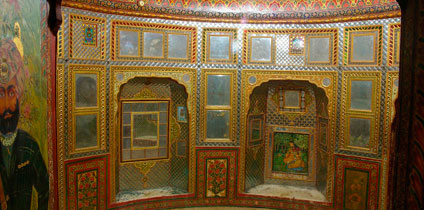
Sheesh Mahal means the palace of mirrors and this is truly designed with colorful glasses and stones. Here you can find the ceiling designed with the map of Nawalgarh and Jaipur, and this Mahal is designed with Rajput craftsmanship.
Morarka Haveli:
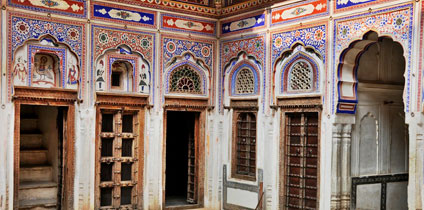
Poddar Haveli is the most famous haveli in Nawalgarh and people may not visit another rich place named Morarka Haveli. If you want to explore some amazing paintings, intricate murals, and artifacts of Rajput dynasty then you must visit this haveli once in your life. But, do not forget to take an attendee to discover the rich history behind this haveli.
Poddar Haveli:
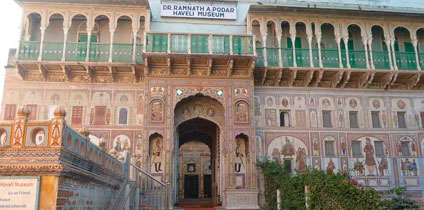
This is not an ancient haveli and Poddar haveli was built in 1920. Here you can find some fresco paintings that describe the modern railways, The Wright Brother’s flight and Hindu god and goddess. Now the Poddar Haveli is known as a museum and you can find knowledgeable guides to describe the history of Nawalgarh.
Roop Niwas palace:
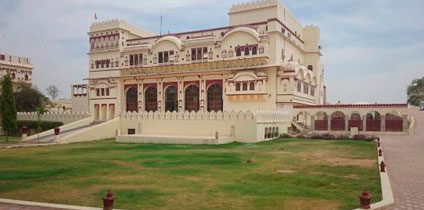
This is the only palace in Nawalgarh where you can find the blend of European styles with Rajput architecture. This palace was used by the Thakur of Nawalgarh and you can find this palace near the Nawalgarh Fort. Now the palace has been converted into a luxurious hotel and you can avail plush facilities of this heritage property.
Fatehpur:

Fatehpur is a part of the Sikar district of Rajasthan and it falls under the Shekhawati region. More than havelis, you can find some ancient temples in Fatehpur, and if you want to explore some new destination that narrates our culture and art then you must visit this place once in your life.
You can easily reach Fatehpur from Delhi via Jaipur Highway and you can find several palaces situated near this highway. However, you must visit the following places in Fatehpur during your trip:
Nadine Cultural Centre:

This haveli was established and owned by the Deora family, and in 1999 a French artist named Nadine Le Prince brought this haveli from the Deora family. He has renovated the haveli and opened a cultural center in this place. Here you can find some fresco paintings crafted with blue shades, and Nadine conducts an art exhibition every year to showcase some contemporary arts.
Dholi Sati Mandir:
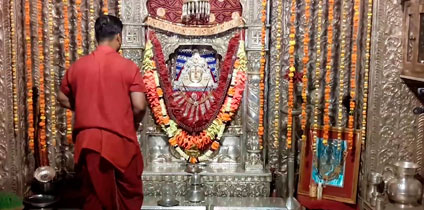
This is the most popular temple in India that dedicated to Sati. The temple is known as Dadi Ji Ki temple in Rajasthan because here Goddess Sati treated as a grandparent of the common people. You can find intricate designs done on marble stones inside this temple and you can also visit the other famous temples in Fatehpur like Dwarkadheesh temple and Balaji Dham.
Jagannath Singhania Haveli:

Fatehpur was known as the house of royal families and this city was decorated or designed by the royal Nawabs of Rajasthan. It was also known as the cultural capital of Shekhawati and you can find the most luxurious haveli named The Jagannath Singhania Haveli in Fatehpur. Along with some artistic fresco paintings and sculptures built in the British period, you can find a Baithak (common hall) in this haveli which has five different floors.
Apart from that, you must visit the Rangeen Karma of this haveli which is decorated with some handmade paintings. Such paintings are based on the life of Lord Krishna, and these paintings will describe the legendary love story between Radha and Krishna. Even a secret chamber of this haveli can give you more and you can explore a well designed underground safety valve in this chamber used by the royal families.
Saraf Haveli:
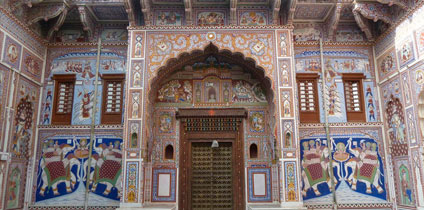
This is the oldest haveli in the country which was built around 200 years ago. Crafted walls with murals and oil paintings and carved wooden doors will give you an insight into our traditional lifestyle. Apart from that, you can also visit the Sitaram Kedia Ki Haveli built by Seth Shree Bohitram Kedia. Here you can find a lush garden decorated with fountains, and you must not forget to visit their library once because this is a majestic library equipped with a huge collection of books.
How to reach Shekhawati?
Shekhawati is well connected by rail, road, and air with the major cities of North India. Shekhawati is situated 250km away from Delhi, and the distance between Shekhawati and Jaipur is 150km approx.
Sanganer Airport Jaipur is the nearest airport of Shekhawati. But, you can also reach New Delhi via flight and take a second flight to reach Shekhawati. Apart from that, you can also reach Shekhawati from Delhi via rail and it will take 4 to 5 hours maximum.
If you want to reach Shekhawati by road then you can take State Highway No 8, 37 or 41. These roads are connected with Delhi, Jaipur, and Bikaner. People can easily book state transport buses to reach Shekhawati. Else, just book a flight or train to Delhi and then take a cab to reach Shekhawati.
People mostly avoid highways and roadways in India because it will take much time due to poor road conditions. But, here you can find smooth operation and the road conditions of such highways between Jaipur and Delhi are good. People lived in Delhi always prefer to visit Shekhawati during their weekend because you can easily reach Shekhawati from Delhi within 4-5 hours by road.
To travel by train in India, it is suggested to book your tickets online and always check the timetable or schedules of such trains before you book. Shekhawati is well connected with international locations because Jaipur and Delhi airport is well connected with international cities.
Best time to visit Shekhawati:
You can visit Shekhawati at any time, but it is better to visit during winter. The temperature during winter remains comfortable and this time is ideal for sightseeing. The best time to visit Shekhawati is from October to December.
Else, you can plan your trip during March to explore Shekhawati in moderate temperatures. The temperature during winter (November to February) in Shekhawati ranges 5°C to 28°C. But, you can find extreme heat during summer and the temperature during summer can reach up to 45°C.
Apart from that, you can visit Shekhawati during monsoon (July-September), and you will feel the cool breeze with a pleasant climate in Shekhawati. Check the Rajasthan Tour Packages of Colorful Indian Holidays to plan your heritage trips to the beautiful places in the state including Shekhawati.
Why would you visit Shekhawati?
Shekhawati is known as “the world’s largest open-air art gallery”. Do not restrict your trip with the famous triangle (Delhi, Jaipur, and Bikaner) and try to discover something unique in Shekhawati. If you are an art lover or have an interest in architecture and history then you must visit this place once in your life.
The old havelis crated with fresco paintings, murals and intricate works on wooden doors will give narrate some pictures based on our old historical facts and mythology. Apart from that, Shekhawati has more than 100 villages and it is quite impossible to cover all these places within a short trip.
But, you can touch the famous places mentioned above and you will find more than 50 forts or havelis in this region. So you will get enough things to know and you can discover a different part of Rajasthan in Shekhawati.
So now you know everything about Shekhawati, and you can plan your trip accordingly. Almost all royal families are indeed shifted to other metropolitan cities from Shekhawati and their palaces are remain neglected. But still, you can explore the old beauty in Shekhawati which cannot be found in any other corner of the world.
To visit this place, it is suggested to plan your trip at least two to three months before because the availability of trains and flights are limited and you may need to pay a high fare to book hotels during peak season. But, if you plan your trip before two to three months then you will get enough time to compare the flights, trains, and hotels, and you can save your cost. Satisfy your lust of traveling the Royal state with Colourful Indian Holiday’s Rajasthan Travel Guide.



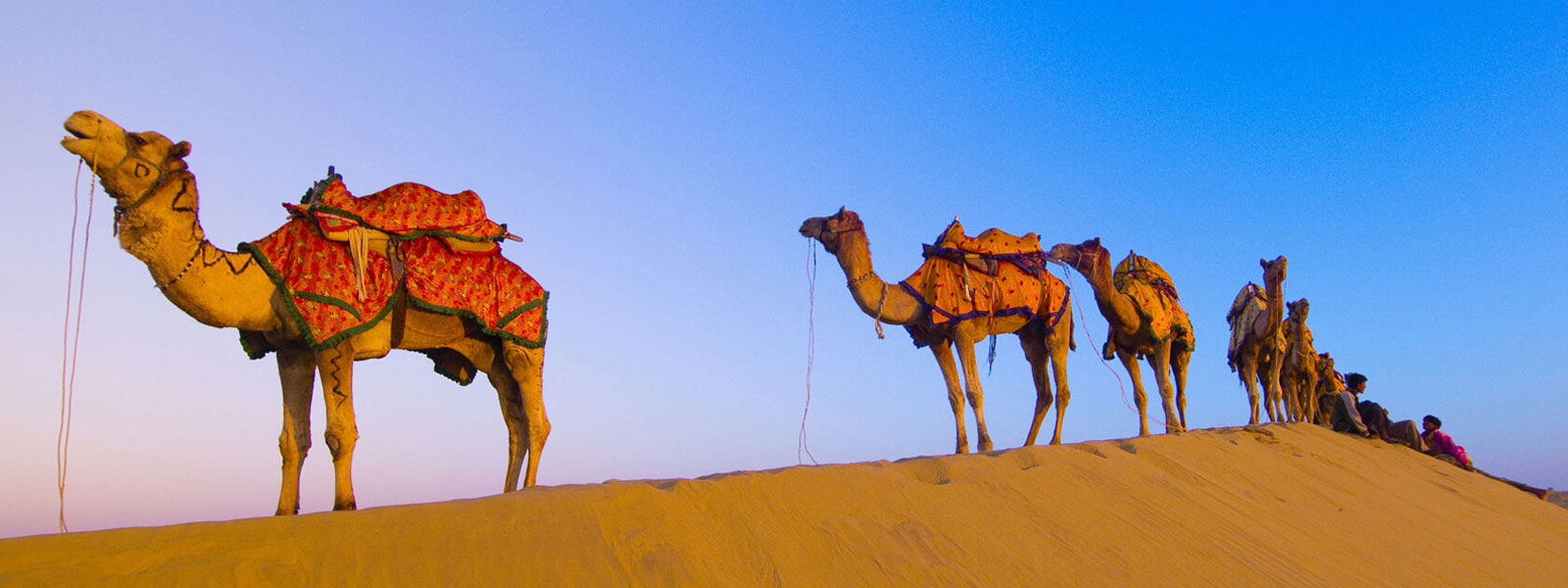
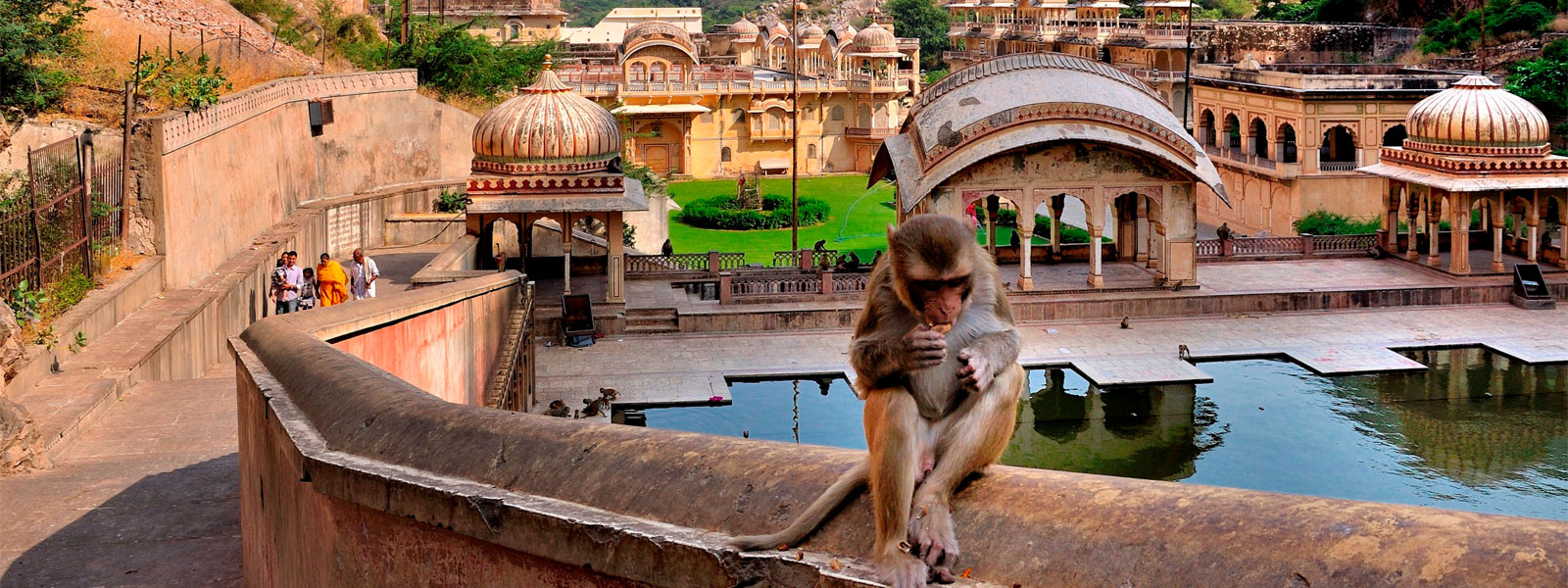

Its amazing article, I went there 2 years back and enjoyed art and paintings. Thanks for sharing a beautiful article.
Thanks for writing an exciting blog posting! I have been to Jaipur and then to Bikaner. I have heard a lot about Shekhawati. and this blog realized me, what I have missed. Please, share this type of post to next time so, we can visit hidden gems.